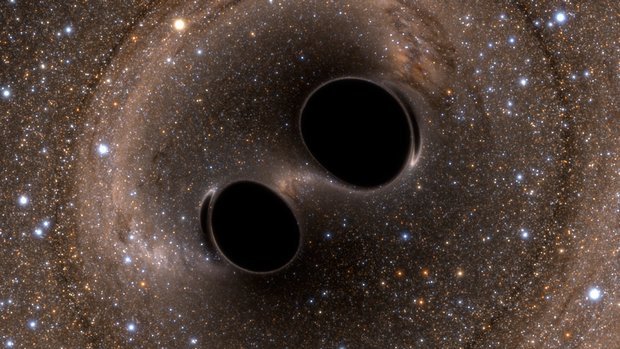Merger of two melnie caurumi has three stages: inspiral, merger and ringdown phases. Characteristic gravitācijas viļņi are emitted in each phase. The last ringdown phase is very brief and encode information about properties of final melnais caurums. Reanalysis of data from binary melnais caurums merger event GW190521 has provided, for the first time, evidence of signature aftershocks of the merger in the form of two separate faint ringdown frequencies produced by the resulting single melnais caurums as it settled down to a stable symmetrical form. This is the first detection of multiple gravitational-wave frequencies in the ringdown stage. Just like a bell ‘rings’ for some time after being stuck, the resulting single distorted melnais caurums formed after the merger ‘rings’ for some time emitting faint gravitācijas viļņi before achieving symmetrical stable form. And, just the way shape of the bell determines the specific frequencies with which the bell rings, similarly, as per no-hair theorem, mass and spin of the melnais caurums determine ringdown frequencies. Hence, this development paves the way for use of ringdown frequencies to study properties of final melnais caurums.
Melnie caurumi are massive objects with extremely strong gravitational fields. When two orbītā melnie caurumi spiral around each other and eventually coalesce, the fabric of telpa-times around them are disturbed that creates ripples of gravitācijas viļņi radiating outwards. Since September 2015 when gravitational-wave astronomy began with LIGO’s first detection of gravitācijas viļņi generated by merger of two melnie caurumi 1.3 billion light years away, merging melnie caurumi are now routinely detected almost once every week.
Uzņēmumu apvienošanās melnie caurumi has three phases. When the two melnie caurumi are widely separated, they slowly orbīta each other emitting weak gravitational waves. The binary gradually moves to smaller and smaller orbītas as the energy of the system is lost in the form of gravitācijas viļņi. Šis ir iedvesmas fāze no saplūšanas. Nākamais ir apvienošanās fāze kad abi melnie caurumi get close enough to coalesce to form a single melnais caurums with distorted shape. Strongest gravitational waves (GWs) are emitted at this stage which are now routinely detected and recorded by gravitational-wave observatories.
Apvienošanās fāzei seko ļoti īss posms, ko sauc izslēgšanas posms wherein the resulting single distorted melnais caurums quickly achieves more stable spherical or spheroidal form. Gravitācijas viļņi emitted in the ringdown phase are damped and much fainter than the GWs released in the merger phase. Just as a bell ‘rings’ for some time after being stuck, the resulting single melnais caurums ‘rings’ for some time emitting much fainter gravitācijas viļņi before achieving symmetrical stable form.
The faint multiple ringdown frequencies of gravitācijas viļņi released during the ringdown phase of merger of two melnie caurumi were undetected so far.
A research team has recently been successful in detecting multiple gravitational-wave frequencies in the ringdown stage of binary melnais caurums merger event GW190521. They searched for individual fading tones in the ringdown frequencies without considering any relation with frequencies and damping times and were successful in identifying two modes implying the resulting deformed melnais caurums emitted at least two frequencies after the merger. This was predicted by Einstein’s general relativity hence the result confirms the theory. Further, researchers compared the frequencies and damping times of the two ringdown modes found in the merger event to test the “no-hair theorem” (that melnie caurumi are completely characterised by mass and spin and no other “hair” is needed to describe its features) and found nothing beyond general relativity.
Tas ir pagrieziena punkts, jo tika plaši uzskatīts, ka vairāku zvana signālu frekvences nebūs iespējams novērot, pirms nākotnē būs pieejami nākamās paaudzes gravitācijas viļņu detektori.
***
Avoti:
- Capano, CD un citi. 2023. gads. Daudzmodu kvazinormāls spektrs no traucēta melnā cauruma. Fiziskās apskates vēstules. Vol. 131, 22. izdevums. 1. gada 2023. decembris. DOI: https://doi.org/10.1103/PhysRevLett.131.221402
- Max-Planck-Institut fürGravitationsphysik (Albert-Einstein-Institut), 2023. Jaunumi – Kam melnais caurums zvana. Pieejams plkst https://www.aei.mpg.de/749477/for-whom-the-black-hole-rings?c=26160
***






































